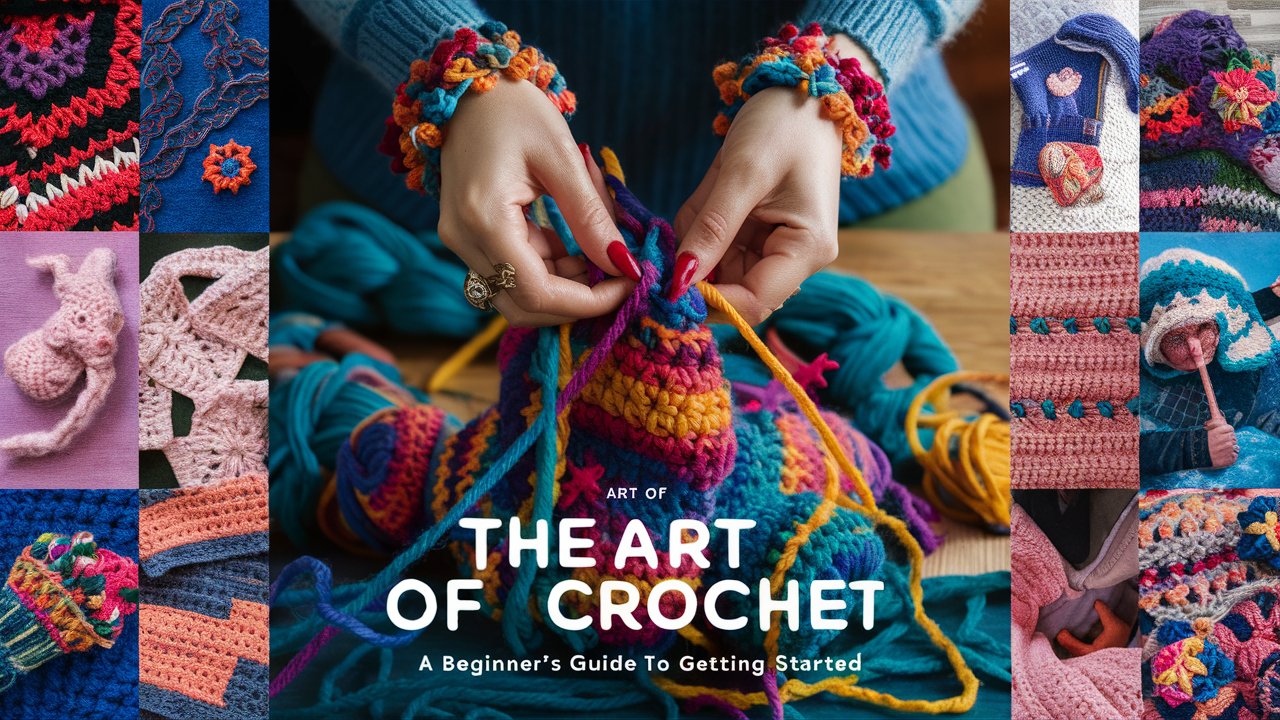Crochet is a timeless craft that has captivated the hearts and hands of many for centuries. Whether you’re looking to create cozy blankets, stylish accessories, or intricate lace patterns, crochet offers endless possibilities for creativity and relaxation. In this beginner’s guide, we’ll explore the basics of crochet, from selecting the right materials to mastering essential stitches. By the end of this post, you’ll be well on your way to starting your first crochet project!
Why Crochet?
Before we dive into the technical aspects, let’s take a moment to appreciate why crochet is such a beloved craft:
- Therapeutic Benefits: Crochet can be incredibly calming and meditative. The repetitive motions can help reduce stress and anxiety.
- Creative Expression: With crochet, you can bring your artistic visions to life. From choosing colors to designing patterns, the creative possibilities are endless.
- Practicality: Crochet items make wonderful gifts and can be practical additions to your home. Think handmade scarves, blankets, and even home decor.
- Community: Joining crochet groups or online forums can connect you with like-minded individuals who share your passion.
Getting Started: Materials You’ll Need

1. Yarn
Yarn is the primary material you’ll need for crochet. It comes in various weights, textures, and colors. Here’s a quick guide to help you choose:
- Weight: Yarn weight ranges from super fine (lace) to super bulky. For beginners, medium-weight yarn (also known as worsted weight) is a great choice as it’s easy to work with.
- Fiber Content: Yarn can be made from natural fibers (like cotton or wool), synthetic fibers (like acrylic), or blends of both. Acrylic yarn is often recommended for beginners due to its affordability and ease of use.
- Color: Choose a color that inspires you! Keep in mind that lighter colors make it easier to see your stitches.
2. Crochet Hook
Crochet hooks come in different sizes and materials (such as aluminum, plastic, or bamboo). The size of the hook you need depends on the weight of your yarn. For medium-weight yarn, a hook size between 5mm (H-8) and 6mm (J-10) is ideal for beginners.
3. Other Essentials
- Scissors: A small pair of scissors for cutting yarn.
- Tapestry Needle: Used for weaving in ends and sewing pieces together.
- Stitch Markers: These help keep track of your place in more complex patterns.
Basic Crochet Stitches
Now that you have your materials ready, it’s time to learn some basic stitches. Here are a few fundamental stitches every beginner should know:
1. Slip Knot
The slip knot is the starting point for most crochet projects.
- Make a loop with your yarn.
- Insert the hook into the loop.
- Pull the yarn through the loop to create a knot on the hook.
2. Chain Stitch (ch)
The chain stitch forms the foundation of most crochet patterns.
- Yarn over (wrap the yarn around the hook).
- Pull the yarn through the loop on the hook.
- Repeat until you have the desired number of chains.
3. Single Crochet (sc)
The single crochet stitch is one of the simplest and most commonly used stitches.
- Insert the hook into the second chain from the hook.
- Yarn over and pull up a loop (you now have two loops on your hook).
- Yarn over again and pull through both loops on the hook.
4. Double Crochet (dc)
The double crochet stitch creates a taller stitch than single crochet.
- Yarn over and insert the hook into the fourth chain from the hook.
- Yarn over and pull up a loop (you now have three loops on your hook).
- Yarn over and pull through two loops (you now have two loops left).
- Yarn over again and pull through both loops.
Starting Your First Project
With these basic stitches under your belt, you’re ready to start your first project! Here are some beginner-friendly ideas:
1. Dishcloth
A dishcloth is a small, simple project that’s perfect for practicing basic stitches.
- Start with a foundation chain of about 25 stitches.
- Work single crochet stitches across each row until you reach your desired length.
- Finish off by weaving in any loose ends with a tapestry needle.
2. Scarf
A scarf is another great beginner project that allows you to practice longer rows of stitches.
- Start with a foundation chain that’s as long as you want your scarf to be wide.
- Work rows of double crochet stitches until your scarf reaches your desired length.
- Add fringe or other embellishments if desired.
3. Granny Square
Granny squares are versatile building blocks for larger projects like blankets or bags.
- Start with a small chain loop.
- Work rounds of double crochet clusters into the loop, following a basic granny square pattern.
- Continue adding rounds until your square reaches your desired size.
Tips for Success
As you embark on your crochet journey, keep these tips in mind:
- Practice Patience: Like any new skill, crochet takes time to master. Be patient with yourself and enjoy the learning process.
- Watch Tutorials: There are countless video tutorials available online that can help you visualize each step.
- Join a Community: Consider joining a local crochet group or an online forum where you can ask questions and share your progress.
- Experiment: Don’t be afraid to try new stitches and techniques as you gain confidence.
Conclusion
Crochet is a rewarding and versatile craft that offers endless opportunities for creativity and relaxation. By starting with basic materials and mastering essential stitches, you’ll be well on your way to creating beautiful handmade items in no time! So grab your yarn and hook, find a comfy spot, and let the art of crochet bring joy into your life.
Happy crocheting!
